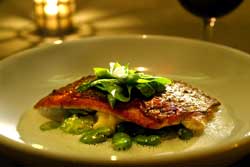Houston Asian Restaurant Guide > Chinese Food Articles > Chinese Cuisines > Zhejiang Cuisine
Comprising local cuisines of Hangzhou, Ningbo and Shaoxing, Zhejiang Cuisine, not greasy, wins its reputation for freshness, tenderness, softness, smoothness of its dishes with mellow fragrance. Hangzhou Cuisine is the most famous one among the three.
Hangzhou cuisine is characterized by its elaborate preparation and varying techniques of cooking, such as sauteing, stewing, and stir- and deep-frying. Hangzhou food tastes fresh and crisp, varying with the change of season. Ningbo food is a bit salty but delicious. Specializing in steamed, roasted and braised seafood, Ningbo cuisine is particular in retaining the original freshness, tenderness and softness. Shaoxing cuisine offers fresh aquatic food and poultry that has a special rural flavor, sweet in smell, soft and glutinous in taste, thick in gravy and strong in season.
Each of the three sub-cuisine traditions is noted for its special flavor and taste, but they are all characterized by the careful selection of ingredients, emphasizing minute preparation, and unique, fresh and tender tastes.
 Zhejiang
cuisine specializes in quick-frying, stir-frying, deep-frying, simmering and
steaming, obtaining the natural flavor and taste. Special care is taken in the
cooking process to make the food fresh, crispy and tender. Thanks to exquisite
preparation, the dishes are not only delicious in taste and but also extremely
elegant in appearance. Zhejiang cuisine is best represented by Hangzhou dishes,
including Hangzhou roast chicken (commonly known as Beggar's chicken), Dongpo
pork, west lake fish in vinegar sauce, Songsao Shredded Fishsoup, etc.
Zhejiang
cuisine specializes in quick-frying, stir-frying, deep-frying, simmering and
steaming, obtaining the natural flavor and taste. Special care is taken in the
cooking process to make the food fresh, crispy and tender. Thanks to exquisite
preparation, the dishes are not only delicious in taste and but also extremely
elegant in appearance. Zhejiang cuisine is best represented by Hangzhou dishes,
including Hangzhou roast chicken (commonly known as Beggar's chicken), Dongpo
pork, west lake fish in vinegar sauce, Songsao Shredded Fishsoup, etc.
Legend has it that Beggar's chicken was invented by a Hangzhou thief. The story goes that because the thief had no stove, he wrapped the stolen bird in clay and baked it in a hole in the ground; another version explains that he was a hungry thief who found a way to cook his bird and keep it and its aroma secret!
